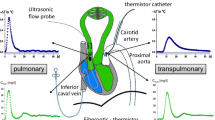Abstract
Lungs from seven healthy female, sea level rats were perfused and ventilated in vitro. Hypoxic pulmonary vasoconstriction was stimulated by changing the inspired gas from 21% oxygen to 6, 4, 3 or 0% oxygen (all gases contained 5% carbon dioxide and balance nitrogen). A sigmoid stimulus-response curve was derived by probit analysis with a 50% of maximum response (ED50) at an oxygen tension of 3.49±0.17 kPa. It is suggested that such characterizations of the response to hypoxia may allow a more precise comparison of the effects of species, age, sex and drugs on hypoxic pulmonary vasoconstriction.
Similar content being viewed by others
References
Barer GR, Howard P, Shaw JW (1970) Stimulus-response curves for the pulmonary vascular bed to hypoxia and hypercapnia. J Physiol (Lond) 211:139–155
Benumof JL, Wahrenbrock EA (1975) Blunted hypoxic pulmonary vasoconstriction by increased lung vascular pressure. J Appl Physiol 38:846–850
Finney DJ (1952) Probit analysis, Cambridge University Press, 2nd ed, pp 183–198
Fishman AP (1976) Hypoxia on the pulmonary circulation. How and where it acts. Circ Res 38:221–231
Grant BJB, Davies EE, Jones HA, Hughes JMB (1976) Local regulation of pulmonary blood flow and ventilation-perfusion ratios in the coati mundi. J Appl Physiol 40:216–228
Hauge A (1969) Hypoxia and pulmonary vascular resistance. The relative effects of pulmonary arterial and alveolarP O 2. Acta Physiol Scand 76, 121–130
Lloyd TC (1983) Relationship between vascular resistance and venous pressure (Letter to Editor). J Appl Physiol 54:321
Marshall BE, Marshall C (1980) Continuity of response to hypoxic pulmonary vasoconstriction. J Appl Physiol 49:189–196
Marshall BE, Marshall C, Benumof J, Saidman LR (1981) Hypoxic pulmonary vasoconstriction in dogs: effects of lung segment size and oxygen tension. J Appl Physiol 51:1543–1551
McMurtry IF, Frith CH, Will DH (1973) Cardiopulmonary responses of male and female swine to simulated high altitude. J Appl Physiol 35:459–462
McMurtry IF, Petrum MD, Reeves JT (1978) Lungs from chronically hypoxic rats have decreased pressor response to acute hypoxia. Am J Physiol 235:H104–109
Rendas A, Branthwaite M, Lennox S, Reid L (1982) Response of the pulmonary circulation to acute hypoxia in the growing pig. J Appl Physiol 52:811–814
Sylvester JT, Harabin AL, Peake MD, Frank RS (1980) Vasodilator and constrictor responses to hypoxia in isolated pig lungs. J Appl Physiol 49:820–825
Tucker A, Rodeghero PT (1981) Vascular responsiveness in isolated rat lungs is inversely related to blood flow. Respiration 42:228–232
Author information
Authors and Affiliations
Rights and permissions
About this article
Cite this article
Marshall, C., Marshall, B.E. Characterization of the stimulus-response curve for hypoxic pulmonary vasoconstriction. Pflugers Arch. 398, 93–95 (1983). https://doi.org/10.1007/BF00581054
Received:
Accepted:
Issue Date:
DOI: https://doi.org/10.1007/BF00581054




